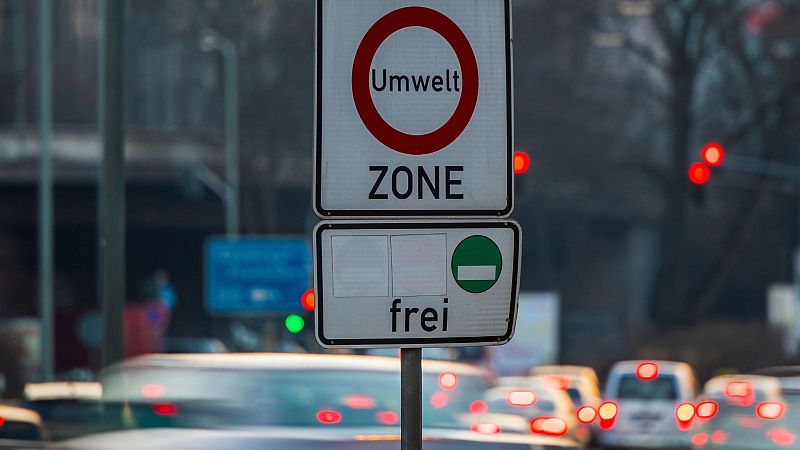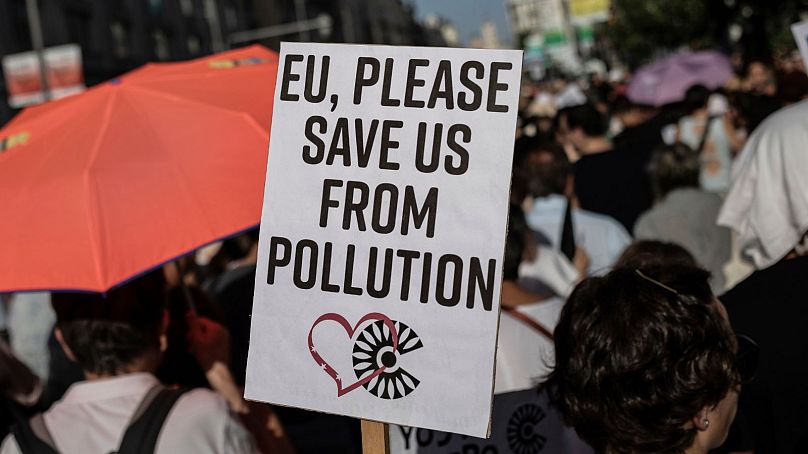‘Personal freedom’ vs ‘greater good’: Low emission zones show EU’s impact on our everyday lives

The European elections are approaching and with them the usual hand-wringing about a lack of interest from the electorate.
The European Union is a behemoth, involved in so many things that even the biggest political enthusiasts find it difficult to keep track.
In the lead-up to June’s elections, expect to see slick campaigns from the institutions and politicians making speeches telling you why you should vote.
But sometimes, breaking down a simple example can be the most effective way to highlight the EU’s impact on our lives.
What are low emission zones?
One example of an EU initiative that affects the majority of Europeans can be found in the transport and organisation of our cities.
If you’ve travelled through Europe in recent years it’s likely you’ve come across brightly coloured circular stickers on car windshields.
The small vignettes are becoming increasingly common and show the environmental status of a vehicle to prove that the owner has permission to drive in the area.
They’re a part of low emission zone schemes that aim to keep the most polluting cars out of the city to improve air quality. Usually, this is done by charging a fee for these vehicles (which are mostly older cars) to enter or just banning them outright.
Many of these zones are funded by the EU and have come as a consequence of EU legislation.
Why are low emission zones controversial in Europe?
Low emissions zones have also become a political battleground in some member states with ‘personal freedom’ pitted against the ‘common good’.
“The narrative has been hijacked,” says Carmen Duce, the Spanish coordinator of the Clean Cities Campaign.
She says despite opposition, the science is clear - people’s quality of life can be improved by low emission zones.
Air pollution is killing thousands of people every year
97 per cent of EU citizens living in urban areas are exposed to air pollution above World Health Organisation’s guidelines.
Speaking at a conference on healthy cities in Brussels last week, Zorana Jovanovic Andersen, a professor of environmental epidemiology at the University of Copenhagen, laid bare the health impacts of this situation.
Over 300,000 premature deaths are caused by air pollution in Europe every year. Poor air quality is also responsible for 20-25 per cent of cardiovascular disease deaths and 10 per cent of lung cancer cases.
That’s before examining its links to brain inflammation and the fast-growing evidence between poor mental health and bad air quality.
On top of that, one of the most affected groups is older people so an ageing population is a vulnerable population.
Given these health and environmental impacts the EU has been continuously legislating in the area.
This is where we can begin to make the link between legislation and regulation at an EU level with its impact on everyday life.
How does the EU make legislation?
The bloc introduced its first air quality directive to tackle the issue in 1980. Over the years, subsequent directives have been introduced to address additional pollutants and to update and strengthen air quality standards and monitoring requirements, including a new version passed just last week.
Directives set certain legally binding end goals or targets, but member states have flexibility on how they achieve them.
It’s through these laws that limits on pollutants have been set.
Member states played a role in negotiating the recent version after it was first suggested by the European Commission. The European Parliament was also involved in the process.
Once directives are adopted, member states are obliged to take the rules and make them part of their own national laws, put them into action, ensure that they are complying and report back to the EU on how they’ve implemented the directive.
In the case of low emission zones, they became part of many of the air quality plans that member states have been obliged to create as the bloc attempts to tackle pollution.
Why is a Spanish city dismantling cycle lanes?
Spain is one country that has really leaned into the measure as a way to combat pollution. In a bid to keep within EU targets, it passed a climate law in 2021 that made it obligatory for every city with over 50,000 inhabitants to introduce a low emission zone.
The country received €1.5 billion in EU funding to help with the implementation of these zones and the sustainable transformation of transportation.
But it has not been an easy road.
Most cities have still not complied despite funding threats and some municipalities are slamming the brakes on their plans. One has even gone so far as to dismantle recently installed cycle paths to better accommodate cars. This has led the European Commission to open a preliminary investigation into the potential misuse of funds.
“The right and the far right are using the car as a symbol of their understanding of freedom,” Duce claims.
Resistance is not just a Spanish phenomenon, however. There have also been protests about the introduction of low emissions zones in Belgium and Germany.
Opponents say that the fines will hit the poorest the hardest and that the zones are an attack on personal freedoms.
In a way, it’s a microcosm of the backlash to the European Green Deal as the continent gears up for the European elections.
While people will continue to argue the case for and against low emission zones, their implementation is a clear example of the influence the EU can have at a national, local and personal level.


